- The application of innovative methodological foundations and the organisation of spaces based on their training model are physically transforming the University
- A clear commitment to using a wide range of methodologies enabling a more competence-based and applied approach to knowledge
The university system is subject to constant changes and transformations, due to the emergence of new ways of learning and generating knowledge, the new profile of its students and the increasingly diverse nature of the training it offers: from bachelor's degree programmes, master's degrees and doctorates to vocational training programmes and lifelong learning.
These are new and different types of teaching, which mean that the university must be open to the world and adapt to circumstances as they emerge, without losing its character as an institution that educates intellects that seek knowledge. The UVic-UCC has risen to this challenge, and has turned it into an opportunity to provide an appropriate response to new demands for training, within three basic areas: placing the student at the centre of the educational process, seeking innovative methodological foundations in order to improve learning processes, and organising spaces based on their educational model.
The University is committed to pedagogical innovation and transformation based on the design and application of the University's own training model, in which digitalisation, multimodality and learning focused on the student provides the framework for all its training
The student at the centre of training
The first area involves the clear commitment to innovation and pedagogical transformation based on the design and application of the University's own training model in which digitalisation, multimodality and learning focused on the student provides the framework for all its training. This model is based on five general principles that guide its teaching style and practice: the student as the centre of their learning and an actor in it; teaching staff that is excellent in teaching, thorough and committed; personal relationships based on dialogue and the desire to educate; emphasis on knowledge, effort, individual and team work and finally, literally placing the whole institution at the service of the students' learning.
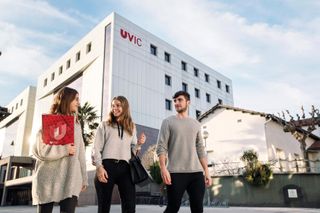
A wide range of methodologies are used to provide a more competence-based and applied approach to knowledge, in which the student is much more significant and participates to a greater extent
Innovative methodological foundations to improve learning processes
The second area of training is based on establishing the pedagogical model, which entailed laying innovative methodological foundations to structure the organisation of the classroom and learning processes. A clear commitment has been made to using a wide range of methodologies that enable a more competence-based and applied approach to knowledge, in which students have a much more significant and participatory role, and which in short, includes the range of skills and knowledge involved in professional work to a much greater extent. Examples of these skills and knowledge include problem-based learning, simulation-based learning, undertaking projects, solving practical cases, case analysis and monitoring, and cooperative learning. This teaching and this way of learning must also be clearly focused on working as a professional, and on the new needs of society. All the practical activities that students undertake in direct contact with companies and institutions in the sector, and the various internships (in Spain, international, curricular, extracurricular, etc.) that students have opportunity to undertake as part of their university education are particularly important in this respect.
A radical reorganisation of learning spaces, environments and processes consistent with the university's training model
The organisation of spaces based on the training model
The third area of this transformation in training has been the radical reorganisation of learning spaces, environments and processes consistent with the university's training model. These spaces also involve an increase and optimisation of virtual learning environments, and the creation of specific areas known as training laboratories. These learning areas are the cornerstones for the skills that students acquire during their training process. These competences will provide the basic and cross-disciplinary skills inherent in university education, above and beyond each specific professional field.
Organisation of spaces at the UVic-UCC in categories
The spaces have been organised in four different categories based on the UVic-UCC training model: teaching classrooms, coworking areas, laboratories, offices and departments. Although each is equipped with its own facilities depending on the activities carried out there, all of them have been conceived and designed based on criteria of flexibility, accessibility, sustainability, adaptability and safety.
Teaching classrooms
For teaching purposes, the faculties have a range of classrooms designed to facilitate training processes. These classrooms have practical and versatile furniture, with dividing panels that are fully equipped for the use of audiovisual and technological resources, in a move towards the concept of the smart classroom. All these features and facilities make the spaces highly adaptable in order to meet teaching needs.
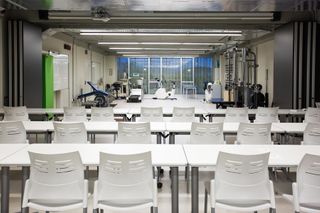
Self-study classrooms
The Self-study Classrooms provide personalised advice and all the equipment students need to work and practice languages at their own pace, and at the times that they are most convenient for them.
These spaces provide the University experience anywhere on the campus
U-Coworking Spaces
These are cross-disciplinary spaces that can be used by the entire community, and are located in the various buildings. They act as spaces for engaging in university life, meeting points, areas for sharing, meeting, work, services and leisure on both a collective and individual basis. They all have the necessary comforts and facilities, and are available in various formats. This means that the most appropriate space for any activity will be available. There are open and closed spaces, both indoors and outdoors, with mobile tables and chairs, armchairs and sofas, whiteboard walls, Internet connections and power sockets, small tiers of seating, workplaces equipped with computers, etc. All these spaces provide the University experience anywhere on the campus.
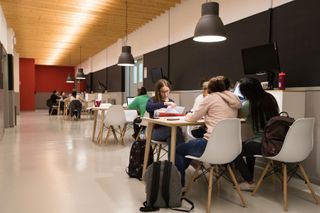
Library
The overall collection is constantly updated and expanding, and includes documents in all types of media and formats. Access to its resources is available from its website. The library's layout also contains spaces for working individually and in small groups, digital access to information (it has its own computer room) and self-study learning and autonomous work.

Virtual Tour:www.uvic.cat/tour-virtual
Discover the classrooms and laboratories where classes are taught on the various degree courses at the UVic, the common areas and the buildings on each campus.
Some examples of the reorganisation of spaces according to the University's own training model
The Montessori Classroom and Teresa Buscart Classroom Children's Education Laboratories
The Montessori Classroom is designed and organised based on the real dimensions used in nursery schools, so that students can use them and learn according to the same processes that the children experience. This makes it possible to practice with materials designed by Maria Montessori herself, which have been certified by the Montessori International Association. It is primarily aimed at students on the Master's Degree in Montessori Education and lifelong learning offered by the UVic-UCC, although it is also used in other specific areas of Education courses.
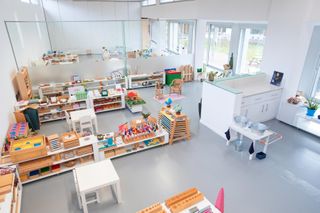
The Teresa Buscart Classroom is a simulation area where Pre-School Teaching Master's degree students and professionals can observe, experiment and discuss good practices at school, and establish an effective relationship between educational theory and practice. It provides opportunity to consider the processes of investigation, experimentation, exploration and reasoning that children engage in when interacting with materials and resources in the classroom. The space is a permanent forum for future pre-school teachers to integrate and transfer their knowledge.
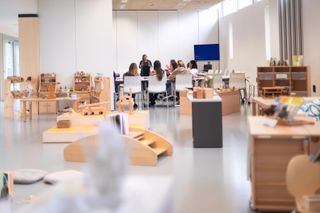
Visual and Plastic Education Classroom
The Classroom fosters autonomy, and encourages investigation, experimentation, manipulation and creation to work in different artistic languages. The furniture consists of modular, mobile and versatile structures that are integrated into the surroundings. These modules can be converted into tables, shelves or display units, as the need arises. The mobility of these items makes it possible to work in an open and creative manner on the ground, on the tables or on magnetised walls. In the Classroom, it is possible to design multifunctional spaces, create areas, environments, work on colours, shapes and materials, and play with light, thanks to the ad hoc lighting design and a system of curtains that regulates the access of natural light.
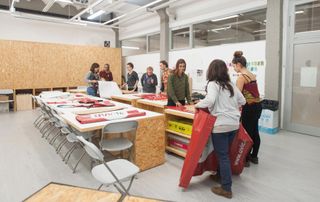
Creativity Laboratory
Designed to stimulate the innovative and creative spirit of the students on degree courses related to business and communication, and to facilitate the achievement of competences in this area that meet the current demands of the labour market. It is equipped with televisions, sofas, modular tables and whiteboard walls, and becomes a space for creativity and generating ideas, debate and planning projects, proposals and entrepreneurial challenges. It is ideal for launching new products, brainstorming sessions and studying new marketing and advertising tools. Different techniques for overall assessment of the student can be used, in what is called a 360 degree assessment.

Industrial Automation and Robotics Laboratory
Complete projects related to industrial automation can be carried out in this laboratory, as it has industrial automatic systems and electronic control and robotic devices that provide students with a closer view of professional work. In this environment, students can engage either independently or with guidance in the various processes and abilities related to industrial automation and carry out the measurements, calculations, studies or reports involved in this field. This space is used for consolidating competences and knowledge, as well as for planning and creating innovative processes (the result of the teaching methodology of project-based learning) and providing responses to the new needs of industry.

Physiotherapy Laboratory
These laboratories designed and equipped for the specific training needs for work in small groups. The teaching methodology is based on case simulation and practical experimentation. The layout of the spaces and the equipment used, similar to the equipment used in physiotherapy centres, means that students can gain experience in the latest techniques in the fields in the profession, such as traumatology and rheumatology, neurology, geriatrics and paediatrics, among others. In these laboratories, the students transfer the conceptual and theoretical foundations they work on in the subjects to an applied perspective.
